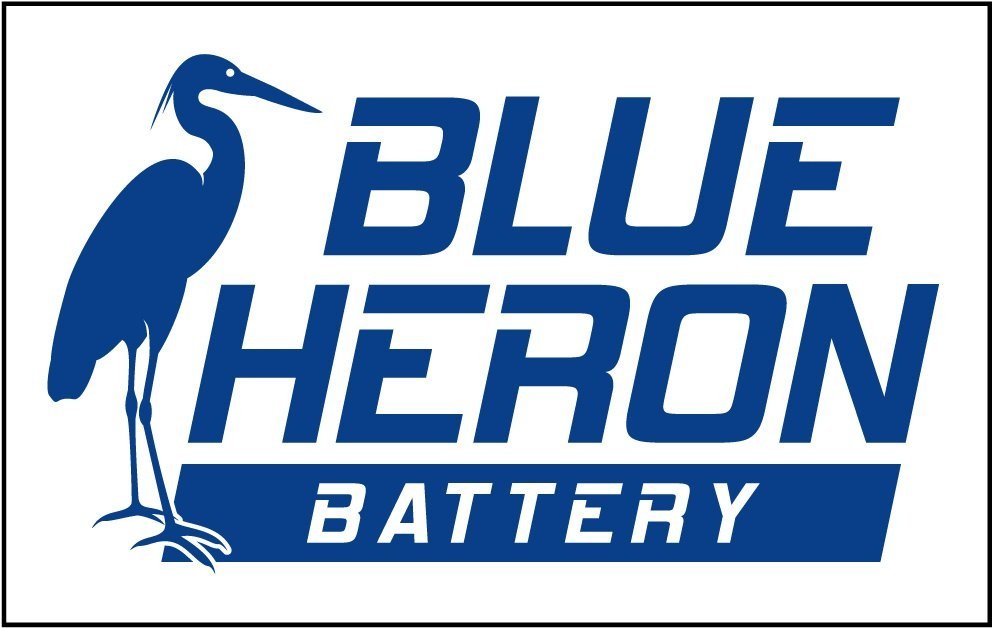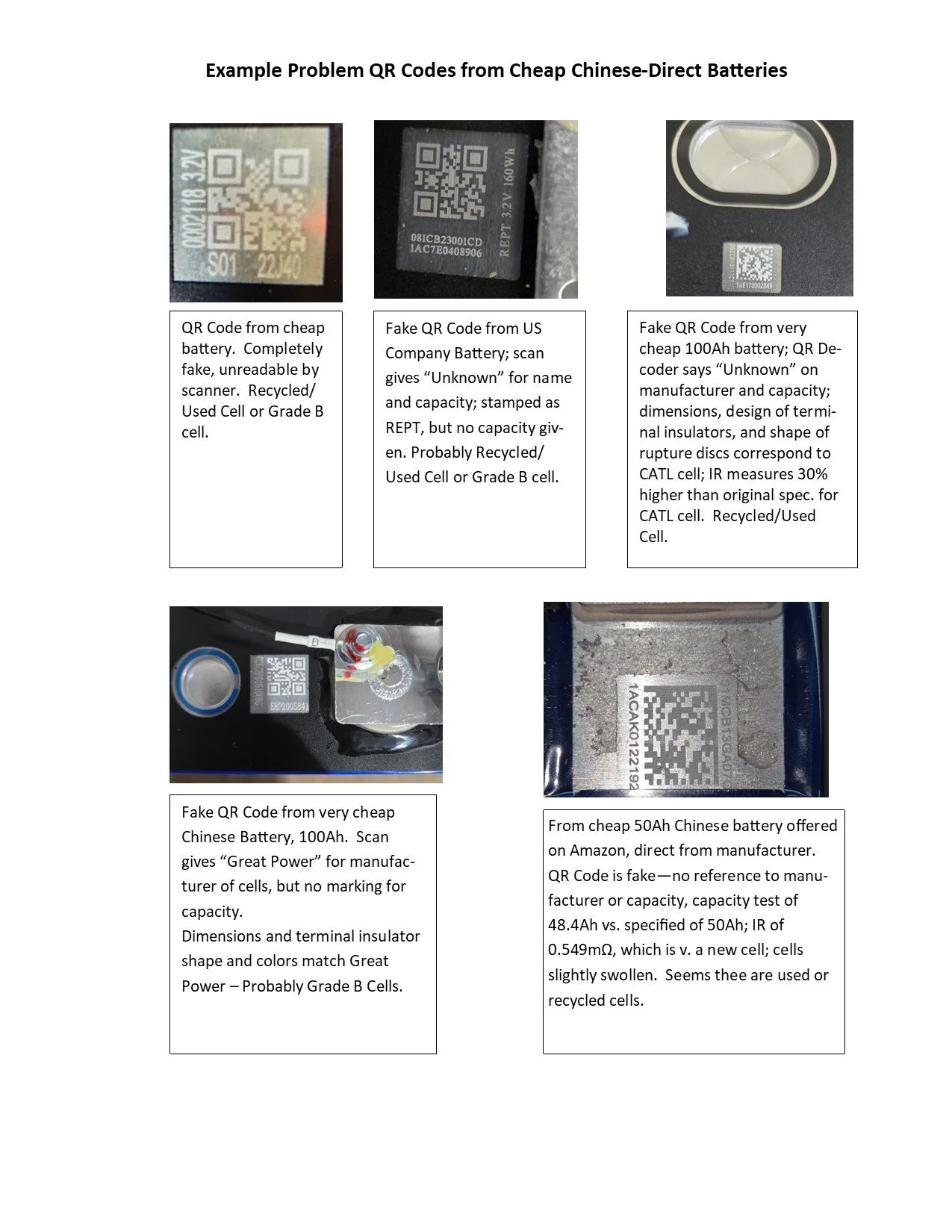
Lithium Battery Landscape – Jan 2025
by Blue Heron Tech. Support Team
A lot has happened over the last 4 years on the availability and acceptance of LIFEPO (LiFePO4) chemistry as the safe lithium-ion chemistry. Thousands (literally) of small Chinese companies have sprouted to sell batteries made with LiFePO4 cells as cheaply as possible. And, in typical Chinese fashion, there are companies with excellent, world class batteries, and then there are innumerable companies making cheap, low-quality batteries and selling directly to the unsuspecting consumer for peanuts. If lithium is so expensive how is this possible? Based on doing technical testing and 15 years working in this field, we have some facts to share.
Lithium Battery Landscape:
If you think you’ve found a deal, chances are you haven’t; you are likely paying more than the battery is worth.
We carefully selected top quality cells 15 years ago, and they lasted in a live-aboard boat for 14 years; and we have other examples. We know how to select the highest quality, long-lasting Li cells.
In China there are large companies (they call them “Listed Companies”) with modern, clean, automated facilities that make long lasting, quality Li cells and batteries, and then hundreds of small shops (“Small-Time Shops”) in dusty old warehouses and sheds.[1]
Proliferation of Cheap Battery Manufacturers – Used and Reject Cells:
Each year in China a billion LiFePO4 cells are removed from the original application, like EV cars, buses and delivery vehicles, and converted into batteries in shiny cases, offered as “deals” but containing used cells.
And, over 5 billion Grade B/Reject cells are put on the market every year. Batches are bought by the Small Time Shops, fabricated into batteries, and sold directly to consumers as “deals” on Amazon, etc., but are over-priced for what one gets.
Characteristics of Listed Companies and Their Products:
The Listed Companies manufacture high quality batteries with Grade A cells, and high Quality Levels
- QL-1 (with Cells rated at 6,000 Cycle or higher – 15-year rated),
- QL-2 (4,000 Cycle Cells – 10-year rated) or
- QL-3 (up to 2,000 Cycle Cells – up to 5-year rated).
Listed Companies sell Lithium Batteries to Distributor OEM Companies in the US and Europe like Blue Heron, Relion, Battleborn, Victron, Ionic.
OEM companies like Blue Heron use in-China independent QC services to inspect cells and batteries before shipment to verify Grade A and a high-quality level.
Listed companies only sell in to OEM companies like Blue Heron. In large (pallet load to container load), and don’t sell to the general public.
Characteristics of Small-Time Shops:
Most Small-Time Shops build their own batteries and only sell directly to American and European consumers (e.g., Amazon, Temu); these batteries are QL-4 (Grade B/Reject Cells) and last 1-3 years.
Other Small-Time Shops sell their batteries direct to American consumers on Amazon, Temu and similar, made with Used/Recycled Cells and last 0-2 years; these are QL-5.
Small-Time shops are not honest on the cells their batteries are made from, sometimes claiming they are Grade A, or use a generalized passive statement about lithium batteries can last 10 years; they don’t tell you there’s will not.
All of the Small-Time Shop’s batteries (cheap stuff on Amazon) we’ve tested are QL-3 or QL-4, that is, Grade B reject cells or QL-5, made with used cells.
Small Time Shops do not allow visitors into their facility, as our QC inspectors have asked to visit. But all the Listed Companies allow QC inspector and visitor access.
Cycle Life Ratings – What They Are:
Cell manufacturers in China are large corporations that supply large businesses around the world, like EV manufacturers, battery manufacturers in China including the Small Time Shops, and manufacturers around the world.
Cell manufacturers rate the cycle life of their cells based on testing. These are observed by Chinese government reps, and are thus reliable.
Battery manufacturers place cycle ratings on batteries, and the accuracy of those battery cycle ratings varies:
- The battery cycle rating should correspond to the cycle rating of the cells, if cells are new, Grade A.
- Many US battery manufacturers place cycle ratings on their batteries that correspond to the cell cycle ratings.
The batteries made by large, Listed Companies generally all have cycle ratings that correspond to cycle ratings of their cells.
The Small-Time Shops rarely have cycle ratings on their batteries that conform to the cell cycle ratings, or that reflect used or reject cells.
First-Hand Experience, Warranties:
We have experience with our batteries with select cells lasting 14 years. Others don’t have that experience.
Warranties are fuzzy with Small-Time Shops – One only has 1year full replacement, then technical support for 4 years, calling that a 5-year warranty but really a 1 year.
Others claim 5 or 10 years, and may replace a battery that lasted only 1 year. But, after that they say you are abusing the battery. Really, a 1-replacement warranty.
YouTube Evaluators:
YouTuber evaluations are inadequate in that they don’t rigorously investigate quality, condition and rating of cells used in the battery.[2]
On-Line YouTubers don’t examine fake QR codes; don’t check cell IR; don’t check cycle ratings against cell manufacturer specs.2
On-Line YouTubers receive kickbacks from battery manufacturers for favorable reviews. Objectivity and rigor are sacrificed
Value Measure:
The best Value Measure is $ per thousand cycles, or $/kCy, to compare across the landscape of cell rated cycles. (Must use Cell manufacturer cycle rating, not Battery Manufacturer claimed cycle rating.)
For example:
(1) A 100Ah battery of Grade B/reject cells or used cells, selling for $200, and expected remaining cycles of 500-1,000, would have a Value Ratio of $200-$400/kCy (dollars per thousand cycles).
(2) A 100Ah battery with Grade A cells and a cell cycle rating of 2,000 cycles selling for $300, would have a Value Ratio of $300/2 or $150/kCy [better value than example (1)].
(3) A 100Ah battery with Grade A cells and a cell cycle rating of 6,000 (e.g., Blue Heron Extreme) selling for $640 would have a Value Ratio of $640/6 or $107/kCy [the Best Value of the three examples].
__________________________________________
[1] Examples of large, Listed Companies that manufacture high quality Li batteries, and in many cases also manufacture LiFePO cells, are Top Band, Gotion, CATL, CALB, BYD, Litshen, REPT, Battero, and Ganfeng.
[2] Examples of Small Time Shops, that are not Listed, and sell cheap batteries, most often with Grade B reject cells or used cells, although some use cheap Grade A cells that have a short rated cycle life. Their batteries can be readily found Amazon.
[3] YouTuber evaluators: fail to scan QR Codes to determine fake vs true; don’t determine who the cell manufacturer is, don’t obtain cell manufacturer specification for the cells, don’t compare cell vs. battery cycle rating, and don’t test against the manufacturer’s specification, such as for Internal Resistance.
Lithium Battery QR Code Conventions
QR Codes are used on new Grade A cells, but also now on Grade B and Recycled/Used cells. China began permitting use of QR Codes on other than Grade B cells, and other products, about 3 years ago. This was desired to assist in inventory control and shipping/receiving these other categories of products. When applied to lesser grade items, the facility processing that item is obligated to leave off the code of the original manufacturer and the item characteristic code, which for lithium cells is the Ah capacity, from the new QR Codes they are applying. The originals are barely etched into the surface and are easily removed by light surfaces sanding.
We have tested dozens of batteries and scanned QR Codes on thousands of cells. That is how we check cells we have purchased on pallet loads, for use in specialty batteries that we fabricate in the US. From the cheap batteries made by others that we’ve tested, here are some examples of QR Codes from those batteries. They all have some deficiency in the QR Code indicating these were Grade B or Recycled/Used cells.

